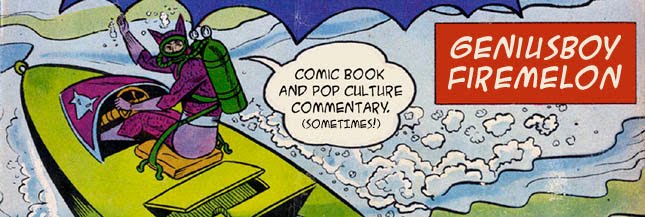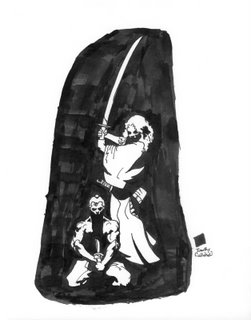 When the credits rolled at the end of The Spirit, and Television's Ryan Callahan (visiting for the Holidays from sunny California) handed me my jacket and prepared to leave the theater, I said, "Why leave now? This is the best part."
When the credits rolled at the end of The Spirit, and Television's Ryan Callahan (visiting for the Holidays from sunny California) handed me my jacket and prepared to leave the theater, I said, "Why leave now? This is the best part."I was referring to the Frank Miller black-and-white illustrations that accompanied the credits, and I wasn't joking. His bold, blocky pen and ink drawings of the Spirit displayed the stark visual aesthetic that would have made a Frank Miller version of The Spirit worth sitting through for nearly two hours.
I'm on the Geoff Klock train of thought regarding this movie, by the way: there's no point even thinking of it as any kind of adaptation of Will Eisner's work. You basically have to approach it as a new creation by Frank Miller, and by taking that angle you don't have to worry about who's going to be rolling over in any graves.
Even by that standard -- even if you look at The Spirit as a cinematic culmination of the Frank Miller sensibility and nothing more -- this thing is a complete failure as a film.
And as a movie that anyone with a heart, mind, and/or soul would want to spend more than a handful of minutes with, it's an unwatchable disaster.
The Spirit is like Sin City mixed with Looney Tunes, minus the humor.
The Spirit is like those bootleg dvds of student film versions of Batman or Spider-Man stories, but with more inconsistent visual appeal.
The Spirit is the kind of movie that might anger you, physically, in nearly every scene.
The Spirit is Boondock Saints for comic book fans, except maybe even worse.
Did you ever see that fight scene that was screened at San Diego this summer? It was on YouTube for a while, though I can't find it now. It had Sam Jackson and Gabe Macht smacking each other around in a mud flat and it was embarassingly bad? The one with the toilet? That scene comes pretty early on in the film, and it sets the tone for what will be a pretty painful experience at the cinema.
One of the running gags in this movie involves the cloned minions of Sam Jackson's Octopus character. They always have names that end in "-os" and at first we get "Pathos" and "Ethos" and "Logos." They don't last all that long, but one of the perks of clone minions is their nearly endless supply (though a non-hilarious plot point is that the supply won't last forever), and so we get more minions later in the film. Like "Huevos" and "Rancheros" and let's not forget "Dildos." And, at the end, what else would we expect but "Adios" and "Amigos."
Yeah, that's the humor of this movie.
 Sam Jackson does tear it up, at least. He is maniacal in all the right ways, like he's performing for a dinner theater crowd who isn't really paying attention. Probably because we're all so engrossed in Gabriel Macht's relentless voice-over about his city. The Spirit and "The City" have a special bond, or so the voice-over keeps telling us. It's a whole lot of meaningless talk -- more in the mold of All-Star Batman and Robin parody than in the mold of any kind of noirish precursors -- and the Spirit will just not shut up about how his city "provides" for him. Sometimes he even turns and addresses the camera, just in case we didn't get the winking tone of the rest of the movie. As bad as all the voice-overs are, at least we get to watch Sam Jackson have all the fun he didn't seem to have playing a Jedi.
Sam Jackson does tear it up, at least. He is maniacal in all the right ways, like he's performing for a dinner theater crowd who isn't really paying attention. Probably because we're all so engrossed in Gabriel Macht's relentless voice-over about his city. The Spirit and "The City" have a special bond, or so the voice-over keeps telling us. It's a whole lot of meaningless talk -- more in the mold of All-Star Batman and Robin parody than in the mold of any kind of noirish precursors -- and the Spirit will just not shut up about how his city "provides" for him. Sometimes he even turns and addresses the camera, just in case we didn't get the winking tone of the rest of the movie. As bad as all the voice-overs are, at least we get to watch Sam Jackson have all the fun he didn't seem to have playing a Jedi.In the middle of it all, we get glimpses of how this movie might have worked, maybe. The flashback funeral-for-Denny-Colt sequence shows a visual grace that's missing from most of the film (which, in general, alternates between cheap-looking stagecraft and random bits of Sin City moments for no particular reason). And when the resurrected Denny Colt visits Dolan (played by Dan Lauria -- the dad from The Wonder Years -- who is really goddamn great in the film, by the way), we see a sepia-toned Dolan through a screen door and a Spirit silhouette and the whole thing just works in a way that the rest of the film doesn't.
Sure, the girls are nice. Eva Mendes is beautiful and Miller decks her out in some costumes that show her off, and Scarlett Johansson is a goofy-hot right hand woman for the Octopus, and that's all well and good, but it doesn't make the movie into anything resembling a story worth caring about (emotionally, intellectually, or even aesthetically, really -- not for 103 minutes).
The plot doesn't even try to make sense, even by what we might derisively call "comic book logic" (though we should know better that to use that term, for a variety of reasons). In once scene, the Spirit recognizes Eva Mendes's Sand Seref by the shape of her photocopied ass, even though he hadn't seen her since she was a much, much thinner teenager. It's not a detective movie, I know, but it's not really anything else either.
 What it is, ultimately, is a Frank Miller-gasm all over the silver screen. It's his familiar territory (harsh city life, lethal beauties, Nazi iconography, scatology, grimly prosaic narration, bombast) writ large. It is a fiercely Milleresque vision, at least. It doesn't seem the least bit compromised by studio interference, and it certainly doesn't feel like any other movie this year. But it's still not any good.
What it is, ultimately, is a Frank Miller-gasm all over the silver screen. It's his familiar territory (harsh city life, lethal beauties, Nazi iconography, scatology, grimly prosaic narration, bombast) writ large. It is a fiercely Milleresque vision, at least. It doesn't seem the least bit compromised by studio interference, and it certainly doesn't feel like any other movie this year. But it's still not any good.Miller famously abandoned his Hollywood hopes a couple of decades ago after the Robocop 2 fiasco, only to be lured back by the siren song of Robert Rodriguez's green screen. The thing is, the completely compromised, soulless Robocop 2 is probably a better movie than the uncompromised, soulless The Spirit.









